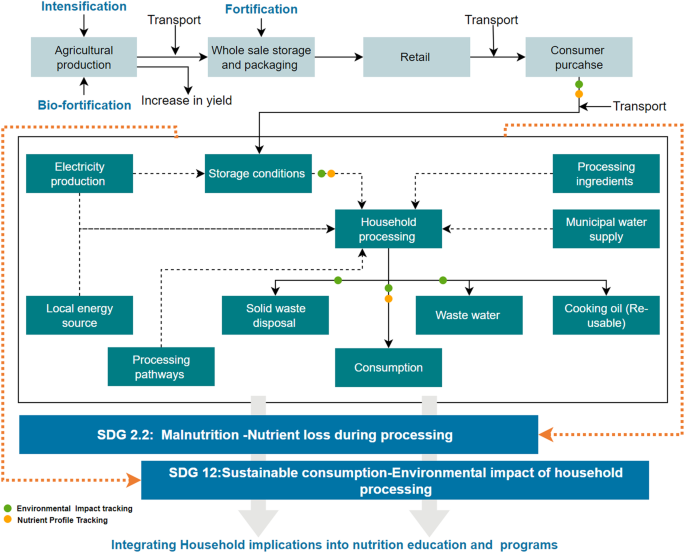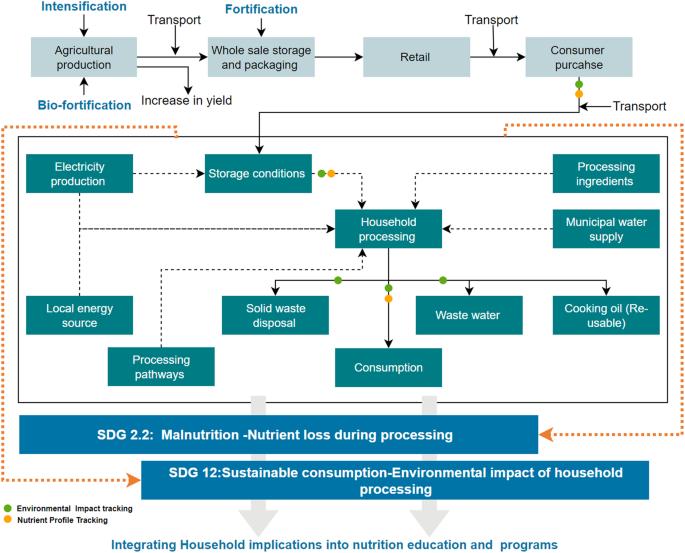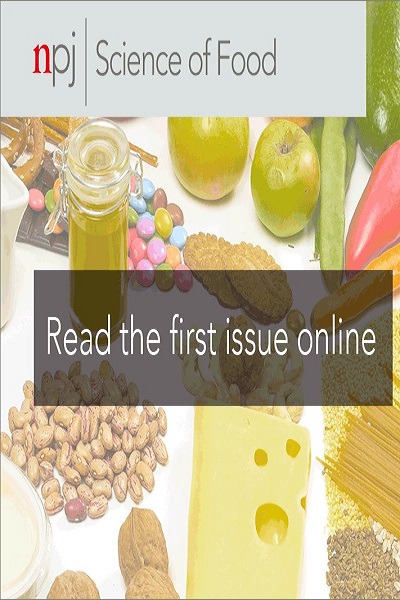马铃薯贮藏和加工过程中的营养与环境权衡,实现可持续健康饮食
IF 6.3
1区 农林科学
Q1 FOOD SCIENCE & TECHNOLOGY
引用次数: 0
摘要
在过去十年中,不良饮食习惯和获得营养食品的机会有限一直是导致人类健康中微量营养素缺乏的关键因素。然而,发达国家工业化规模的食品强化已经帮助消除了与缺乏有关的疾病。在发展中国家,强化食品和生物强化材料被送往营养缺乏的社区。虽然这些战略取得了显著的成果并受到好评,但粮食及农业组织的报告显示,全球超过四分之一的人口患有微量营养素缺乏症。这意味着在食品价值链(FVC)的不同节点上,食品中的微量营养素仍在下降。因此,本研究以美国的马铃薯家庭储藏、加工和消费为案例,追踪食品价值链特定节点的微量营养素流失情况。实验采用全因子设计,有三种储存条件(橱柜储存条件(17.5-22.4 °C,32.7-48%相对湿度)、冰箱储存条件(-1.8 - 0.89 °C,37.5-66.1%相对湿度)和理想储存条件(7.2-11.1 °C、85.0-92.4% 相对湿度))、两种储存时间(2 周(±3 天)和 5 周(±3 天))和三种家庭加工途径(水煮、204 °C烘焙和 149-204 °C植物油煎炸)。此外,我们还通过对环境可持续性或营养保留的高优先级、低优先级或同等优先级,探索了最佳家庭储存和加工途径的动态变化。结果表明,与储存 2 周(±3 天)后的类似加工方案相比,储存 5 周(±3 天)并通过煮沸(100 ℃水中)、烘焙(204 ℃)和油炸(149-204 ℃植物油中)加工马铃薯的营养损失分别增加 33.5%、40.3% 和 15.0%。此外,在 5 周(±3 天)后储存和加工马铃薯对人类健康、生态系统安全和资源可用性造成的损害是 2 周(±3 天)后储存和加工马铃薯的约 2.2 ± 0.7 倍,这是不同储存条件下的平均值。5 周(±3 天)后储存和加工马铃薯对人类健康、每年消失的物种和美元损失造成的损害是新鲜购买和加工马铃薯的 53.6 ± 10.3 倍。这项研究最重要的发现可能是,将马铃薯储存在橱柜中并煮熟(BL-CP 途径)是实现可持续健康饮食的最佳方法,因为它能实现营养保留和低环境损害的最佳组合。在消费者权衡家庭马铃薯贮藏和加工过程中环境可持续性与营养价值时,可以将这项研究的见解转化为支持消费者决策的依据。本文章由计算机程序翻译,如有差异,请以英文原文为准。


Nutritional-environmental trade-offs in potato storage and processing for a sustainable healthy diet
Over the last decade, poor diets and limited access to nutritious foods have been critical drivers of micronutrient deficiency in human health. However, food fortification at an industrialized scale in developed countries has helped eliminate deficiency-related diseases. In developing countries, fortified foods and biofortified materials have been delivered to nutrient-deficient communities. While these strategies have produced significant and acclaimed results, reports from the Food and Agricultural Organization suggest that over a quarter of the world’s population suffers from micronutrient deficiency. This implies that there are still declines in micronutrients in food products at different nodes along the food value chain (FVC). Hence, this study sets out to track micronutrient leakages at specific nodes of the FVC using potato household storage, processing, and consumption in the United States as a case study. The experiment was laid out in a full factorial design with three storage conditions (cupboard at (17.5–22.4 °C, 32.7–48% RH), refrigerator at (–1.8 – 0.89 °C, 37.5–66.1% RH) and ideal condition at (7.2–11.1 °C, 85.0–92.4% RH)), two storage times (2 weeks (±3 days) and 5 weeks (±3 days)) and three household processing pathways (boiling in water, baking at 204 °C, and frying in vegetable oil at 149–204 °C). Additionally, we explored the dynamics of optimal household storage and processing pathways by placing a high, low, or equal priority on environmental sustainability or nutrient retention. The results show that storing potatoes for 5 weeks (±3 days) and processing through boiling (in water at 100 °C), baking (at 204 °C), and frying (in vegetable oil at 149–204 °C) are associated with 33.5%, 40.3% and 15.0% greater nutrient loss than a similar processing scenario after 2 weeks (±3 days) of storage. Additionally, storing and processing potatoes after 5 weeks (±3 days) results in approximately 2.2 ± 0.7 times more damage to human health, ecosystem safety, and resource availability than storing and processing potatoes after 2 weeks (±3 days), averaged between the different storage conditions. Storing and processing after 5 weeks (±3 days) results in approximately 53.6 ± 10.3 times more damage to human health, species disappearing per year, and USD loss than freshly purchased and processed potatoes. Perhaps the most significant finding from the study is that storing potatoes in cupboards and boiling (BL-CP pathway) is optimal for achieving a sustainable healthy diet, as it yields the optimal combination of nutrient retention and low environmental damage. Insights from the study could be translated to support consumer decision-making as they weigh the value of environmental sustainability against nutrition in the context of household potato storage and processing.
求助全文
通过发布文献求助,成功后即可免费获取论文全文。
去求助
来源期刊

NPJ Science of Food
FOOD SCIENCE & TECHNOLOGY-
CiteScore
7.50
自引率
1.60%
发文量
53
期刊介绍:
npj Science of Food is an online-only and open access journal publishes high-quality, high-impact papers related to food safety, security, integrated production, processing and packaging, the changes and interactions of food components, and the influence on health and wellness properties of food. The journal will support fundamental studies that advance the science of food beyond the classic focus on processing, thereby addressing basic inquiries around food from the public and industry. It will also support research that might result in innovation of technologies and products that are public-friendly while promoting the United Nations sustainable development goals.
 求助内容:
求助内容: 应助结果提醒方式:
应助结果提醒方式:


